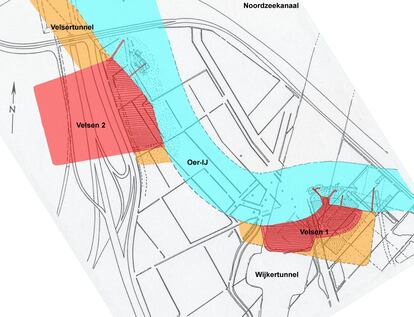The third Roman emperor, Caligula, was the son of an important general, Germanicus, but he lacked military experience. He needed a great victory to show his worth, and what better than to invade Britain, a campaign started already in the time of Julius Caesar. To try again, it was necessary to protect the northernmost limit of the Empire in Europe, still expanding, from the Germanic tribes. Two millennia ago, that front crossed the territory of what is now the Netherlands along the Rhine. There, near Amsterdam, it has now been discovered that a fort considered minor had the capacity for a legion - made up of up to 6,000 men - and it must have been established by Caligula to facilitate the invasion. He could not carry it out because he was assassinated in the year 41. His successor, Claudio, took advantage of that military stronghold and, as of 43,it took control of the center and the south of the island of Great Britain.
More information
Caligula, not so bad actually
Known to date as Velsen 2 (there is a Velsen 1), the fort is in the municipality of the same name
(Flevum,
in Latin) located about 38 kilometers from the Dutch capital.
Today, part of the original land is occupied by a tunnel for the railway and road traffic called the Velsertunnel.
The Roman fortification was shaped like the letter V and was surrounded by narrow channels to hinder an enemy assault.
“It could host almost a legion, numbering between 5,000 and 6,000 soldiers, and these were reserved for areas of great strategic value.
From there they could repel possible attacks by the Germanic tribes while the emperor concentrated on the assault on England ”, explains the Dutch archaeologist Arjen Bosman, who has made the discovery.
The tribes in question were the Caucuses, distributed to the northwest of the coast of Germany, between Friesland (to the west) and the estuary of the Elbe river (to the east).
The invasion of Britain was prepared from Gaul and entered from the south.
Then the continental flanks had to be protected to avoid distractions.
View of the excavations at Fort Velsen 2, in 1964 Courtesy of Arjen Bosman
Bosman says wooden planks have been recovered from under what must have been the fort's watchtower "and are dated to the winter of AD 42-43, just before the invasion of Britain."
"When I found out, I saw that everything fit together," he says.
According to his analysis, Caligula was in present-day Netherlands "because his initials have been found on wooden barrels from the Roman imperial court in two other places, Valkenburg and Vechten," but he was unable to lead the assault across the sea. .
He was assassinated by the Praetorian Guard in early 41, in a conspiracy involving senators and courtiers.
The Praetorians later declared Claudius, Caligula's uncle, emperor.
Map of the two forts, Velsen 1 and Velsen 2, along the Rhine River Courtesy of Arjen Bosman
The find is unique, since the first Roman remains found in this area date back to 1945. Some schoolchildren then collected pieces of pottery in an anti-tank trench abandoned by the Germans in the Second World War. In the 1950s, during the construction of the Velsertunnel, which runs under the North Sea Canal, more remains appeared. In the 1960s and 1970s, the excavations were expanded and consolidated. Bosman's parents, amateur archaeologists, took him to the same area in 1964 in a stroller. In 1972 a first fort was discovered, called Velsen 1. It was about two hectares and could accommodate between 500 and 1,000 men. In 1997, Bosman found Roman canals at three locations about two kilometers from Velsen 1, as well as a wall and a gate. They corresponded to another fort,which was called Velsen 2, and the land was declared a protected area for its great archaeological value.
Roman legionary spearhead, from Fort Velsen 2 Courtesy of Arjen Bosman
Despite the importance of the excavation, for years the two fortifications were believed to be minor in character.
But Bosman was not quite convinced that Velsen 2 contained numerous fragments of Roman helmets, spearheads, sword sheaths, and daggers.
It was an arsenal that did not fit with a small fort.
Now comparing the remains collected in 1966 and 1970 on the slopes for the water and gas lines west of the Velsertunnel - which had not been recognized as Roman - with his own finds, he has seen that “Velsen 2 was a much larger fort of what was believed and destined for the legion ”.
“A military unit with very different orders.
For this reason, if we think of 11 hectares and up to 6,000 soldiers, it all works out ”.
Iron arrowhead on wooden shaft, from Fort Velsen 2 Courtesy of Arjen Bosman
The Romans considered the south of present-day Dutch territory as a valuable region, with fertile soil, and they settled in places such as present-day Maastricht. North of the Rhine, on the other hand, they could hardly take anything. “It was poor in raw materials. There was some amber in it, or maybe they were interested in women's hair, which was used to make Roman wigs. Little more. Food and drink were brought from other places and could not be compared with Hispania or Gaul; however, it had great strategic value ”, he says. He also believes that troops from other parts of the Empire came to the fort, including Hispania, and stresses that their women and children accompanied them. They know it because they have found typical female brooches from the north of the Alps and children's shoes. Velsen 2 was abandoned in AD 47,when Emperor Claudius ordered the withdrawal of his troops behind the Rhine.






/cloudfront-eu-central-1.images.arcpublishing.com/prisa/SD75LX5OYJHF7H7TKLOMS5ZSNM.jpg)


